Apatite, a gemstone often overlooked in the shadow of more renowned jewels, possesses a certain allure that can captivate those who discover it. Its relative obscurity in mainstream gemstone culture does not diminish the fact that apatite's diverse hues and interesting properties make it a remarkable scientific and aesthetical stone. Elegant and chameleonic in its various colours, apatite is as versatile as enchanting, meriting a closer look by gemstone enthusiasts and casual observers alike.
With its rich history and varied applications, apatite's story is as layered as the stone's. Despite its deceptive name—which originates from the Greek word 'to deceive'—apatite's genuine qualities in metaphysical beliefs and practical uses, such as in jewelry, continue to pique the interest of those versed in gemological lore.
Key Takeaways
-
Apatite stands out for its vibrant range of colours and versatility.
-
Its unique history and metaphysical significance distinguish the gemstone.
-
Despite its lesser-known status, apatite remains a favourite among gem collectors and jewelry makers.
Apatite Properties

Apatite is a group of phosphate minerals notable for its substantial phosphorus content. These minerals are composed of calcium phosphate combined with fluorine, chlorine, or hydroxyl, with the chemical formula Ca5(PO4)(F,OH,Cl). They exhibit considerable stability and do not readily dissolve in natural conditions. Intriguingly, apatite can absorb radioactive contaminants, offering a method for containing and removing them from environments and groundwater.
The physical properties of apatite minerals are diverse:
-
Clarity: Apatite’s clarity ranges from translucent to transparent, allowing light penetration and showcasing the mineral’s vibrant hues.
-
Hardness: On the Mohs scale, apatite is relatively soft, with a hardness rating typically around 5. This makes it less ideal for certain types of jewelry.
-
Colours: Elements like fluorine, chlorine, and hydroxyl contribute to apatite’s colours. This leads to variations such as fluorapatite and chlorapatite, which display their unique properties through different coloration.
The mineral’s appearance is versatile. Sometimes, it features hexagonal crystal forms, while other samples may resemble raw quartz chunks with a more opaque quality. These forms are highly sought after for lapidary crafts, such as carvings, tumbled stones, and beads.
It’s important to note that while apatite is fairly common, gemstone-quality specimens are considered rare. The mineral’s brittleness also adds to its scarcity in mainstream jewelry outlets. Nonetheless, apatite remains a cherished mineral among independent jewelry designers for its distinctive beauty and the unique qualities it brings to artisanal creations.
Apatite Stone Colour

Apatite stones exhibit a diverse palette of colours, each variant contributing to its allure. The chart below outlines the primary colours and their characteristics:
| Colour | Description |
| Blue |
Ranges from the soft sky to Robin’s egg blue are often associated with peace. Blue gems of the apatite series can be found in sizes over 5 carats, and exceptional stones have exceeded 100 carats. These blue gems also exhibit strong blue and yellow pleochroism. |
| Green |
Varies from spring green to deep teal, the most common apatite colour. |
| Yellow |
Bright and cheerful, yellow apatite exudes warmth. |
| Purple |
A less common hue, purple apatite mirrors the mystery of its colour. |
Green apatite is prevalent, enhancing its appeal to enthusiasts and collectors alike. Blue apatite draws attention for its serene qualities, while yellow and purple (sometimes referred to as violet) add a vibrant touch to the spectrum. Some stones are colourless, with a clarity that rivals a diamond‘s brilliance, further broadening their appeal. The intensity of apatite’s colouration is often vivid, regardless of the stone’s natural or polished state.
The History of Apatite
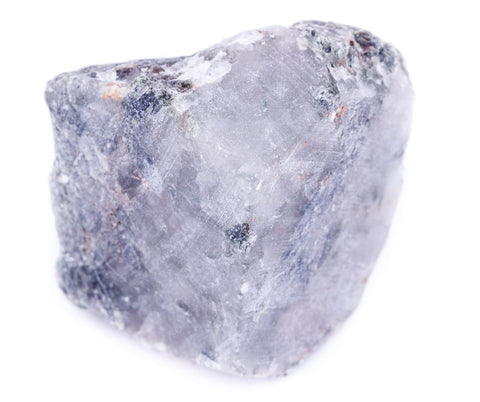
Apatite was discovered in 1786. Its name comes from the Greek for "to deceive" due to its visual similarity to other minerals like peridot and beryl. Apatite is heavily utilized for its phosphorus, a vital element in many products. It also boasts a significant presence in jewelry.
Historical Applications:
-
Phosphate mineral mining for phosphorus content.
-
Production of chemicals, fertilizers, and acids.
Ornamental Use:
-
High-quality apatite is faceted for jewelry.
Note: Apatite's history reflects its dual role as an industrial and a gemstone resource.
A Few Fun Facts about Apatite
Moon Rocks Contain Apatite
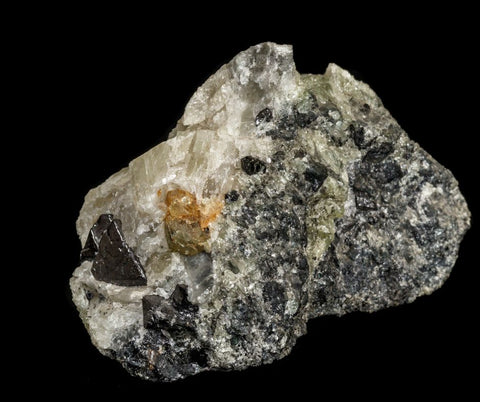
Apatite is not just an Earth-bound mineral but is also found in lunar rocks collected during the Apollo missions. The presence of apatite in moon rocks provides valuable clues about the moon's geological history and interior processes, including the existence of water in the moon's past.
Fluorescent Properties
Some varieties of apatite exhibit strong fluorescence under ultraviolet light. This characteristic makes it a favourite among mineral collectors. The fluorescence is due to rare earth elements or other impurities within the crystal structure, which can give apatite a striking appearance under UV light.
Apatite and Human Teeth
Apatite's chemical composition is remarkably similar to human tooth enamel, making it a subject of interest in dental research. Synthetic apatite materials are being explored for dental restoration and repair, offering the potential for biomimetic applications that mimic tooth enamel.
A Window into Earth's Past Atmospheres
Apatite crystals can trap small amounts of water and gases during their formation. By analyzing these inclusions, scientists can gain insights into the conditions of Earth's atmosphere and hydrosphere billions of years ago. This makes apatite an invaluable tool in studying our planet's early history.
Rare Transparent Gems
Transparent apatite gems are relatively rare, making them highly prized among collectors. The most sought-after colour is the neon blue-green variety, often called “Paraíba” apatite, reminiscent of the vivid colours in Paraíba tourmalines.
Cat's eye apatite, known for its chatoyancy effect, can be found in various colours. This phenomenon is caused by parallel fibrous or needle-like inclusions that interfere with the passage of light in the crystal.
Where is Apatite Found?
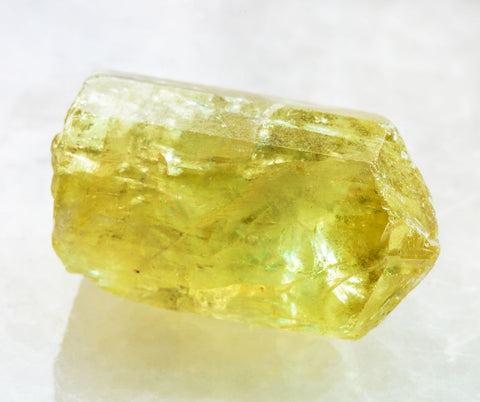
Apatite, a phosphate mineral, is predominantly found in various geological settings, including metamorphic, sedimentary, and igneous rocks. Marine environments rich in phosphatic debris notably enhance apatite crystallization in sedimentary formations.
Notable global apatite sources:
-
China: Leading producer of phosphate rock.
-
Morocco, Russia, Western Sahara, United States: Significant apatite deposits used for phosphorus.
When it comes to gem-quality apatite, certain countries stand out:
-
Brazil and Canada: Renowned for high-quality gemstones.
-
India, Madagascar, Mexico: Key players in the gemstone market.
Other regions are known for unique colour variations:
-
Germany, Italy, Myanmar: Sources of colourless apatite.
-
Germany, Portugal, United States: Known for violet apatite
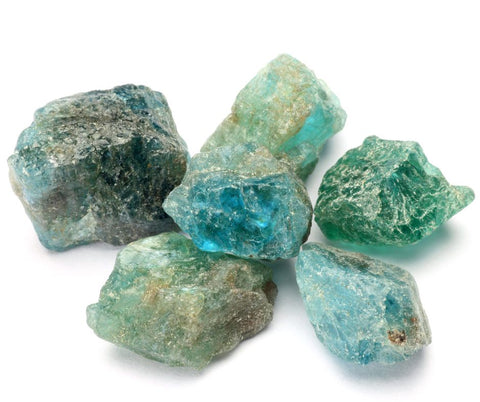
Apatite Jewelry
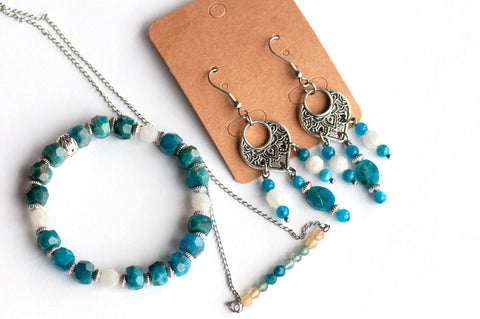
Faceted apatite is central in crafting sparkling rings, earrings, and pendants. Faceting enhances the stone's natural transparency or translucency, allowing it to shimmer and showcase its unique colours effectively.
Apatite gemstones not suited for faceting due to quality are often shaped into cabochons or beads, offering variety in the form of pendants and rings with cabochon cuts, and necklaces, bracelets, and earrings adorned with beads.
Care Tips for Apatite Jewelry:
-
Cleaning should involve lukewarm water and mild soap.
-
A soft brush is ideal for dislodging potential accrued materials.
-
Abrasive substances must be avoided to prevent scratching.
Due to its brittleness, it's wise for apatite jewelry, especially bracelets and rings, to be worn carefully to mitigate the risk of cracking caused by sharp impacts during vigorous activities.
Available Apatite Jewelry Pieces:
-
Rings: Elegance for everyday wear with mindful handling.
-
Earrings and Pendants: Safe from high-impact activities, exemplifying apatite's allure.
-
Strand Necklaces and Bead Bracelets: Versatile beads offering casual elegance.
For a selection of handpicked apatite jewelry, customers are invited to explore our exclusive collection. Shop our Apatite Jewelry Collection
Apatite Meaning
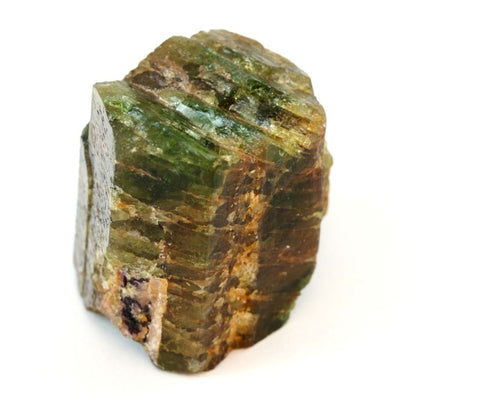
Apatite Metaphysical Properties
Apatite gems are believed to bring forth relaxation and calm, offering peace to those who utilize them in their spiritual practices. This stone is often associated with:
-
Calm and relaxation: Induces peaceful states of being
-
Balance and clarity: Enhances mental equilibrium and clear thinking
-
Self-expression: Promotes open and honest communication
Wearing apatite is believed to enhance focus, clarity for concentration, intellect, acceptance, and unconditional love for oneself and others.
Apatite’s reputed ability to facilitate emotional healing is linked to its purported impact on balancing emotions and promoting growth in self-expression.
Using Apatite in Chakra Balancing
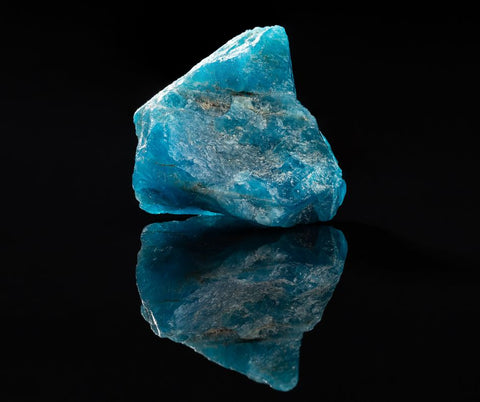
Apatite is commonly associated with different chakras based on its colour:
-
Blue Apatite: Linked with the Throat Chakra, aiding communication and self-expression.
-
Green Apatite: More connected to the Heart Chakra, aligning with emotion and compassion.
Practitioners may use apatite to balance these energy centers, enhancing areas like communication for the Throat Chakra and emotional well-being for the Heart Chakra.
Using Apatite in Feng Shui
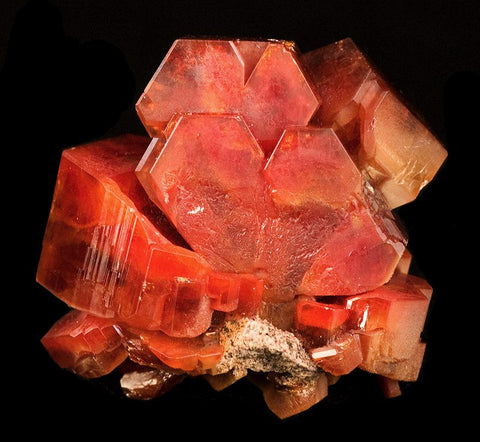
In Feng Shui, apatite can be strategically placed to work harmoniously with the spatial energy. It's believed to help:
-
Reduce stress: By creating a tranquil environment.
-
Promote intellect and focus: Ideal for study areas or workplaces.
-
Enhance personal and spiritual growth: Suitable in meditation spaces.
Its role in Feng Shui is to help clear negativity while enhancing knowledge and concentration in areas where intellectual work or meditation takes place.
Stones Similar to Apatite
Gem enthusiasts frequently encounter confusion when identifying stones due to their similar appearances. Green apatite, for example, could be easily mistaken for peridot due to their shared green hue.
Furthermore, beryl emerges as an alternative to various apatite colours. In its pure form, beryl lacks colour but can exhibit green, yellow, and blue shades akin to apatite when introduced to impurities.
Similar to certain apatite colours are spinels, zircons, and even differently tinted diamonds. Links to further information on these gemstones are as follows:
Quartz is another gemstone that can be misconceived as apatite, particularly with larger, more opaque carved pieces. However, quartz generally lacks the intense colour that characterizes apatite.
Frequently Asked Questions
What are the distinguishing properties of green apatite?
-
Colour: Varies from translucent sea-green to rich grassy green.
-
Clarity: Commonly found with inclusions; transparent pieces are rare.
-
Lustre: Vitreous, giving a glass-like sheen.
-
Geological Presence: Often discovered in metamorphic rocks and pegmatite deposits.
How can blue apatite influence one's spiritual well-being?
-
Inspiration: Believed to stimulate creativity and intellect.
-
Communication: Linked with enhancing clarity in communication.
-
Spiritual Connection: Associated with deepening and spiritual attunement.
What are the primary uses of apatite gemstones?
-
Jewellery: Crafted into earrings, pendants, and rings.
-
Collectible: Valued by collectors for its wide colour range.
-
Metaphysical: Used in crystal healing therapies.
-
Industrial: As a phosphate source in fertilizers (non-gemstone grade).
In what ways can yellow apatite affect my energy levels?
-
Energizing: Thought to stimulate a sense of brightness and enthusiasm.
-
Motivation: Said to encourage positive assertiveness and proactivity.
-
Chakra Association: Connected to the solar plexus chakra, influencing personal power and energy.
What aspects of physical healing are attributed to red apatite?
-
Bone Health: Believed to aid in strengthening bones and promoting calcium absorption.
-
Circulation: Alleged to assist blood-related issues.
-
Vitality: Associated with improving vitality and physical energy.
Can black apatite have an impact on emotional balance?
-
Protective Qualities: Considered to offer shielding against negative energies.
-
Grounding: Linked with grounding and stabilizing emotional turbulence.
-
Self-reflection: Thought to help in uncovering hidden fears and overcoming obstacles.









